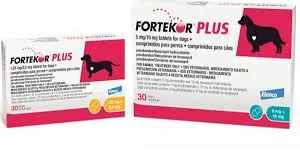- NAME OF THE VETERINARY MEDICINAL PRODUCT
FORTEKOR PLUS 1.25 mg/2.5 mg tablets for dogs FORTEKOR PLUS 5 mg/10 mg tablets for dogs
- QUALITATIVE AND QUANTITATIVE COMPOSITION
Each tablet contains:
Active substances:
|
|
Pimobendan |
Benazepril |
|
|
|
hydrochloride |
|
FORTEKOR PLUS 1.25 mg/2.5 mg tablets |
1.25 mg |
2.5 mg |
|
FORTEKOR PLUS 5 mg/10 mg tablets |
5 mg |
10 mg |
|
Excipients: |
|
|
|
|
|
|
|
|
Brown oxide |
|
|
|
iron E172 |
|
|
FORTEKOR PLUS 1.25 mg/2.5 mg tablets |
0.5 mg |
|
|
FORTEKOR PLUS 5 mg/10 mg tablets |
2mg |
|
For the full list of excipients, see section 6.1.
- PHARMACEUTICAL FORM
Oval, bilayer tablets, white and light brown, with a score line on both sides.
The tablets can be divided into equal halves.
- CLINICAL PARTICULARS
4.1 Target species
Dogs.
4.2 Indications for use, specifying the target species
For the treatment of congestive heart failure due to atrioventricular valve insufficiency or dilated cardiomyopathy in dogs. FORTEKOR PLUS is a fixed-dose combination and should only be used in subjects whose clinical signs are successfully treated by simultaneous administration of the same doses of the individual components (pimobendan and benazepril hydrochloride).
4.3 Contraindications
It is not used in case of hypertrophic cardiomyopathies or clinical conditions in which increasing the heart rate is not possible for functional or anatomical reasons (e.g. aortic or pulmonary stenosis).
Do not use in case of hypotension, hypovolemia, hyponatremia or acute renal failure.
Do not use during pregnancy and lactation (see section 4.7).
Do not use in case of hypersensitivity to the active substances or any of the excipients.
4.4 Special warnings for each target species
It doesn't exist.
4.5 Special precautions for use
In the case of chronic kidney disease, it is recommended to check the dog's hydration status before starting therapy and to monitor plasma creatinine and the number of erythrocytes in the blood during therapy.
As pimobendan is metabolised in the liver, the product should not be administered to dogs suffering from severe hepatic impairment.
The efficacy and safety of the product have not been established in dogs weighing less than 2.5 kg or under 4 months of age.
Special precautions to be taken by the person administering the veterinary medicinal product to animals
Wash your hands after use.
People with known hypersensitivity to pimobendan or benazepril hydrochloride should avoid contact with the veterinary medicinal product.
In case of accidental oral ingestion, seek medical advice immediately and show the package leaflet or the label to the physician.
Pregnant women should take special care to avoid accidental oral exposure, as angiotensin-converting enzyme (ACE) inhibitors have been shown to affect the fetus during human pregnancy.
4.6 Adverse reactions (frequency and seriousness)
Pimobendan
In rare cases, a moderate positive chronotropic effect and vomiting may occur. These effects are, however, dose-dependent and can be avoided by reducing the dose in such situations.
In rare cases, transient diarrhea, anorexia or lethargy have been observed.
Benazepril hydrochloride
A small number of dogs may experience transient vomiting, incoordination, or signs of fatigue. In dogs with chronic kidney disease, benazepril may increase plasma creatinine levels at the beginning of therapy. The modest increase in plasma creatinine levels following administration of ACE inhibitors is consistent with the reduction in glomerular hypertension induced by these agents, so there is no reason to stop treatment in the absence of other signs.
The frequency of adverse reactions is defined using the following convention:
- very common (more than 1 in 10 animals showing adverse reactions during a treatment)
- common (more than 1 but less than 10 animals in 100 animals)
- uncommon (more than 1 but less than 10 animals in 1,000 animals)
- rare (more than 1 but less than 10 animals in 10,000 animals)
- very rare (less than 1 animal in 10,000 animals, including isolated reports)
4.7 Use during pregnancy or lactation Do not use during pregnancy or lactation.
The safety of FORTEKOR PLUS has not been tested in dogs during breeding, gestation or lactation.
Laboratory studies in rats and rabbits with pimobendan have shown fetotoxic effects at maternally toxic doses. Laboratory studies in rats and rabbits with pimobendan have shown no effect on fertility. Laboratory studies in rats have shown that pimobendan is excreted in milk.
Laboratory studies in rats with benazepril have shown fetotoxic effects (fetal urinary tract malformation) at maternally non-toxic doses. It is not known whether benazepril is secreted in the milk of lactating bitches.
4.8 Interaction with other medicinal products and other forms of interaction
In dogs with congestive heart failure, benazepril hydrochloride and pimobendan have been administered in combination with digoxin and diuretics without demonstrable adverse interactions.
In pharmacological studies, no interaction was detected between the cardiac glycoside ouabain and pimobendan. The increase in cardiac contractility induced by pimobendan is attenuated in the presence of the calcium antagonist verapamil and the β-antagonist propranolol.
In humans, the combination of angiotensin converting enzyme (ACE) inhibitors and non-steroidal anti-inflammatory drugs (NSAIDs) may lead to reduced antihypertensive efficacy or renal impairment. Therefore, the concomitant use of FORTEKOR PLUS with NSAIDs or any other drug with a hypotensive effect should be carefully considered before using such combinations.
The combination of FORTEKOR PLUS and other antihypertensive agents (e.g. calcium channel blockers, β-blockers or diuretics), anaesthetics or sedatives may lead to additive hypotensive effects. Renal function and signs of hypotension (lethargy, weakness, etc.) should be closely monitored and treated as necessary.
Interactions with potassium-sparing diuretics such as spironolactone, triamterene or amiloride cannot be excluded. Therefore, monitoring of plasma potassium levels is recommended when FORTEKOR PLUS is used in combination with potassium-sparing diuretics due to hyperkalemia.
4.9 Amounts to be administered and route of administration
Oral administration.
Dosage and treatment regimen
FORTEKOR PLUS is a fixed combination product that should only be used in dogs that require both active substances to be administered concomitantly at this fixed dose.
The recommended dose range for FORTEKOR PLUS is 0.25 - 0.5 mg pimobendan per kg body weight and 0.5 - 1 mg benazepril hydrochloride per kg body weight divided into two daily doses. FORTEKOR PLUS tablets should be administered orally, twice daily, 12 hours apart (morning and evening) and approximately 1 hour before feeding.
The tablets can be broken along the midline.
The table below can be used for guidance.
|
Weight |
Strength and number of tablets to be administered |
|
||||
|
FORTEKOR PLUS 1.25 mg/2.5 mg |
FORTEKOR PLUS 5 mg/10 mg |
|||||
|
dog (kg) |
tablet |
|
tablet |
|
||
|
|
Morning |
|
Evening |
Morning |
|
Evening |
|
2.5 - 5 |
0.5 |
|
0.5 |
|
|
|
|
5 - 10 |
1 |
|
1 |
|
|
|
|
10 - 20 |
|
|
|
0.5 |
|
0.5 |
|
20 - 40 |
|
|
|
1 |
|
1 |
|
|
|
|
|
|||
|
Over 40 kg |
|
|
|
2 |
|
2 |
4.10 Overdose (symptoms, emergency procedures, antidotes), as appropriate
In case of overdose, the dog should be treated symptomatically. Transient reversible hypotension may occur in case of accidental overdose. Therapy will consist of intravenous infusion (IV) of warm isotonic saline as required.
4.11 Waiting time
That's not the case.
5.1 Pharmacodynamic properties
Benazepril hydrochloride is a prodrug that is hydrolyzed in vivo to its active metabolite, benazeprilat. Benazeprilat is a highly potent and selective ACE inhibitor, preventing the conversion of inactive angiotensin I to active angiotensin II, thereby reducing aldosterone synthesis. Benazepril therefore blocks the effects mediated by angiotensin II and aldosterone, including vasoconstriction of arteries and veins, sodium and water retention by the kidneys, and remodeling effects (including pathological cardiac hypertrophy and degenerative renal changes).
In dogs with congestive renal failure, benazepril hydrochloride reduces blood pressure and volume load on the heart. Benazepril prolonged the time to worsening heart failure and death, improved clinical status, reduced coughing, and improved exercise tolerance in dogs with symptomatic congestive heart failure caused by valvular disease or dilated cardiomyopathy.
Pimobendan, a benzimidazole-pyridazinone derivative, is a non-sympathomimetic, non-glycoside, inotropic agent with effective vasodilator properties. It increases the calcium sensitivity of cardiac myofilaments and inhibits phosphodiesterase (type III). It also exhibits vasodilator action by inhibiting the activity of phosphodiesterase type III.
5.2 Pharmacokinetic particularities
Absorption
After oral administration of pimobendan alone, the absolute bioavailability of the active ingredient is 60-63%. As this bioavailability is considerably reduced when pimobendan is administered with food or shortly thereafter, it is recommended to treat animals approximately 1 hour before feeding.
Following oral administration of benazepril hydrochloride alone, systemic bioavailability is incomplete (~13%) in dogs due to incomplete absorption (38%) and first-pass metabolism. Benazepril levels decline rapidly as the drug is partially metabolized to benazeprilat by hepatic enzymes. There is no significant difference in the pharmacokinetics of benazeprilat when benazepril hydrochloride is administered to fed or fasted dogs.
Following oral administration of FORTEKOR PLUS tablets at twice the recommended dose in dogs, peak levels of both components are reached rapidly (Tmax 0.5 hours for benazepril hydrochloride and 0.85 hours for pimobendan), with peak concentrations (Cmax) for benazepril hydrochloride of 35.1 ng/ml and 16.5 ng/ml for pimobendan. Peak levels of benazeprilat were observed after 1.9 hours with peak concentrations (Cmax) of 43.4 ng/ml.
Distribution
The steady-state volume of distribution is 2.6 l/kg after intravenous administration of pimobendan alone, indicating that pimobendan has already distributed into tissues. The mean in vitro plasma protein binding is 93%.
Benazeprilat concentrations decline in a biphasic manner: the initial, rapid phase (t1/2 = 1.7 hours) represents the elimination of free drug, while the terminal phase (t1/2 = 19 hours) reflects the release of benazeprilat that has been bound to ACE, primarily from tissues. Benazepril and benazeprilat are extensively bound to plasma proteins (85-90%), and in tissues they are found primarily in the lungs, liver, and kidneys.
Repeated administration of benazepril hydrochloride leads to a slight bioaccumulation of benazeprilat (R = 1.47), with steady state being achieved within a few days (4 days).
Metabolism
Pimobendan is oxidatively demethylated to its main metabolite, O-desmethyl pimobendan.
The next metabolic pathways are phase II, glucuronides and sulfates.
Benazepril hydrochloride is partially metabolized by liver enzymes to the active metabolite benazeprilat.
Elimination
The elimination half-life of pimobendan dosed with FORTEKOR PLUS tablets is 0.5 hours, consistent with the high clearance of the compound. The major active metabolite of pimobendan is eliminated with a half-life of 2.6 hours. Pimobendan is excreted primarily in the feces and, to a lesser extent, in the urine.
The elimination half-lives of benazepril hydrochloride and benazeprilat, when dosed with FORTEKOR PLUS tablets, are 0.36 hours and 8.36 hours, respectively. Benazeprilat is excreted via the biliary (54%) and urinary (46%) routes in dogs. Benazeprilat clearance is not affected in dogs with impaired renal function; therefore, no dosage adjustment of FORTEKOR PLUS is necessary in dogs with renal impairment.
6.2 Incompatibilities
That's not the case.
6.3 Shelf life
Shelf life of the veterinary medicinal product as packaged for sale: 18 months
Any remaining half tablets should be discarded after 1 day.
6.4 Special precautions for storage
Store below 25°C.
Keep the blister in the outer carton in order to protect from moisture.
Any remaining half tablet should be placed back in the opened blister and kept (for no more than 1 day) in the original carton, out of the sight and reach of children.
6.5 Nature and composition of primary packaging
Tablets of both strengths are packaged in aluminum/aluminum blisters placed in an outer cardboard box.
1.25 mg/2.5 mg tablets: pack size of 30
5 mg/10 mg tablets: pack size of 30
- DENOMINAZIONE DEL MEDICINALE VETERINARIO
FORTEKOR PLUS 1,25 mg/2,5 mg compresse per cani FORTEKOR PLUS 5 mg/10 mg compresse per cani
- COMPOSIZIONE QUALITATIVA E QUANTITATIVA
Ogni compressa contiene:
Sostanze attive:
|
|
Pimobendano |
Benazepril |
|
|
|
cloridrato |
|
FORTEKOR PLUS compresse da 1,25 mg/2,5 mg |
1,25 mg |
2,5 mg |
|
FORTEKOR PLUS compresse da 5 mg/10 mg |
5mg |
10mg |
|
Eccipienti: |
|
|
|
|
|
|
|
|
Ossido marrone |
|
|
|
ferro E172 |
|
|
FORTEKOR PLUS compresse da 1,25 mg/2,5 mg |
0,5 mg |
|
|
FORTEKOR PLUS compresse da 5 mg/10 mg |
2mg |
|
Per l'elenco completo degli eccipienti, vedere paragrafo 6.1.
- FORMA FARMACEUTICA
Compresse ovali, a doppio strato, di colore bianco e marrone chiaro, con una linea di frattura su entrambi i lati.
Le compresse possono essere divise in metà uguali.
- PARTICOLARI CLINICI
4.1 Specie bersaglio
Cani.
4.2 Indicazioni per l'uso, specificando le specie di destinazione
Per il trattamento dell'insufficienza cardiaca congestizia dovuta a insufficienza della valvola atrioventricolare o a cardiomiopatia dilatativa nei cani. FORTEKOR PLUS è una combinazione a dose fissa e deve essere utilizzato solo nei soggetti i cui segni clinici sono trattati con successo mediante la somministrazione simultanea delle stesse dosi dei singoli componenti (pimobendan e benazepril cloridrato).
4.3 Controindicazioni
Non viene utilizzato in caso di cardiomiopatie ipertrofiche o condizioni cliniche in cui l'aumento della frequenza cardiaca non è possibile per ragioni funzionali o anatomiche (ad esempio stenosi aortica o polmonare).
Non usare in caso di ipotensione, ipovolemia, iponatriemia o insufficienza renale acuta.
Non usare durante la gravidanza e l'allattamento (vedere paragrafo 4.7).
Non usare in caso di ipersensibilità ai principi attivi o ad uno qualsiasi degli eccipienti.
4.4 Avvertenze speciali per ciascuna specie bersaglio
Non esiste.
4.5 Precauzioni speciali per l'uso
In caso di malattia renale cronica, si raccomanda di controllare lo stato di idratazione del cane prima di iniziare la terapia e di monitorare la creatinina plasmatica e il numero di eritrociti nel sangue durante la terapia.
Poiché il pimobendan viene metabolizzato nel fegato, il prodotto non deve essere somministrato a cani affetti da grave compromissione epatica.
L'efficacia e la sicurezza del prodotto non sono state stabilite nei cani di peso inferiore a 2,5 kg o di età inferiore a 4 mesi.
Precauzioni speciali che devono essere adottate dalla persona che somministra il medicinale veterinario agli animali
Lavarsi le mani dopo l'uso.
Le persone con nota ipersensibilità al pimobendan o al benazepril cloridrato devono evitare il contatto con il medicinale veterinario.
In caso di ingestione orale accidentale, consultare immediatamente un medico mostrandogli il foglietto illustrativo o l'etichetta.
Le donne incinte devono prestare particolare attenzione a evitare l'esposizione orale accidentale, poiché è stato dimostrato che gli inibitori dell'enzima di conversione dell'angiotensina (ACE) possono avere effetti sul feto durante la gravidanza umana.
4.6 Reazioni avverse (frequenza e gravità)
Pimobendano
In rari casi possono verificarsi un moderato effetto cronotropo positivo e vomito. Questi effetti, tuttavia, dipendono dal dosaggio e possono essere evitati riducendo la dose in tali situazioni.
In rari casi sono stati osservati diarrea transitoria, anoressia o letargia.
Benazepril cloridrato
Un piccolo numero di cani può presentare transitoriamente vomito, mancanza di coordinazione o segni di affaticamento. Nei cani affetti da malattia renale cronica, il benazepril può aumentare le concentrazioni plasmatiche di creatinina all'inizio della terapia. L'aumento moderato delle concentrazioni plasmatiche di creatinina dopo somministrazione di ACE inibitori è compatibile con la riduzione dell'ipertensione glomerulare indotta da questi agenti, pertanto non vi è motivo di interrompere il trattamento in assenza di altri sintomi.
La frequenza delle reazioni avverse è definita utilizzando la seguente convenzione:
- molto comune (più di 1 animale su 10 mostra reazioni avverse durante un trattamento)
- comune (più di 1 ma meno di 10 animali su 100 animali)
- non comune (più di 1 ma meno di 10 animali su 1.000 animali)
- raro (più di 1 ma meno di 10 animali su 10.000 animali)
- molto raro (meno di 1 animale su 10.000 animali, comprese le segnalazioni isolate)
4.7 Uso durante la gravidanza o l'allattamento Non usare durante la gravidanza o l'allattamento.
La sicurezza di FORTEKOR PLUS non è stata testata nei cani durante la riproduzione, la gestazione o l'allattamento.
Studi di laboratorio su ratti e conigli con pimobendan hanno dimostrato effetti fetotossici a dosi maternotossiche. Studi di laboratorio condotti su ratti e conigli con pimobendan non hanno evidenziato effetti sulla fertilità. Studi di laboratorio sui ratti hanno dimostrato che il pimobendan viene escreto nel latte.
Studi di laboratorio sui ratti con benazepril hanno dimostrato effetti fetotossici (malformazione del tratto urinario fetale) a dosi non tossiche per la madre. Non è noto se il benazepril venga secreto nel latte delle cagne in allattamento.
4.8 Interazioni con altri medicinali ed altre forme di interazione
Nei cani con insufficienza cardiaca congestizia, il benazepril cloridrato e il pimobendan sono stati somministrati in combinazione con digossina e diuretici senza interazioni avverse dimostrabili.
Negli studi farmacologici non è stata rilevata alcuna interazione tra il glicoside cardiaco ouabaina e il pimobendan. L'aumento della contrattilità cardiaca indotto dal pimobendan risulta attenuato in presenza del calcio antagonista verapamil e del β-antagonista propranololo.
Negli esseri umani, la combinazione di inibitori dell'enzima di conversione dell'angiotensina (ACE) e farmaci antinfiammatori non steroidei (FANS) può portare a una ridotta efficacia antipertensiva o a disfunzione renale. Pertanto, l'uso concomitante di FORTEKOR PLUS con FANS o qualsiasi altro farmaco con effetto ipotensivo deve essere attentamente valutato prima di ricorrere a tali combinazioni.
L'associazione di FORTEKOR PLUS con altri farmaci antipertensivi (ad esempio calcio antagonisti, beta-bloccanti o diuretici), anestetici o sedativi può portare ad effetti ipotensivi additivi. La funzionalità renale e i segni di ipotensione (letargia, debolezza, ecc.) devono essere attentamente monitorati e trattati secondo necessità.
Non si possono escludere interazioni con i diuretici risparmiatori di potassio, come spironolattone, triamterene o amiloride. Pertanto, si raccomanda il monitoraggio dei livelli plasmatici di potassio quando si utilizza FORTEKOR PLUS in combinazione con diuretici risparmiatori di potassio a causa dell'iperkaliemia.
4.9 Dosi da somministrare e via di somministrazione
Somministrazione orale.
Dosaggio e regime di trattamento
FORTEKOR PLUS è un prodotto a combinazione fissa che deve essere utilizzato solo nei cani che necessitano della somministrazione concomitante di entrambi i principi attivi a questa dose fissa.
L'intervallo di dose raccomandato per FORTEKOR PLUS è 0,25 - 0,5 mg di pimobendan per kg di peso corporeo e 0,5 - 1 mg di benazepril cloridrato per kg di peso corporeo, suddivisi in due dosi giornaliere. Le compresse di FORTEKOR PLUS devono essere assunte per via orale due volte al giorno, a distanza di 12 ore (mattina e sera) e circa 1 ora prima dei pasti.
Le compresse possono essere rotte lungo la linea mediana.
La tabella seguente può essere utilizzata come guida.
|
Peso |
Dosaggio e numero di compresse da somministrare |
|
||||
|
FORTEKOR PLUS 1,25 mg/2,5 mg |
FORTEKOR PLUS 5 mg/10 mg |
|||||
|
cane (kg) |
tavoletta |
|
tavoletta |
|
||
|
|
Mattina |
|
Sera |
Mattina |
|
Sera |
|
2,5 - 5 |
0,5 |
|
0,5 |
|
|
|
|
5 - 10 |
1 |
|
1 |
|
|
|
|
10 - 20 |
|
|
|
0,5 |
|
0,5 |
|
20 - 40 |
|
|
|
1 |
|
1 |
|
|
|
|
|
|||
|
Oltre 40 kg |
|
|
|
2 |
|
2 |
4.10 Sovradosaggio (sintomi, procedure di emergenza, antidoti), a seconda dei casi
In caso di sovradosaggio, il cane deve essere trattato in base ai sintomi. In caso di sovradosaggio accidentale può verificarsi un'ipotensione transitoria e reversibile. La terapia consisterà nella somministrazione di infusioni endovenose (infusioni endovenose) con soluzione salina isotonica calda, secondo necessità.
4.11 Tempo di attesa
Non è così.
5.1 Proprietà farmacodinamiche
Il benazepril cloridrato è un profarmaco che viene idrolizzato in vivo nel suo metabolita attivo, ovvero il benazeprilato. Il benazeprilato è un ACE inibitore altamente efficace e selettivo, che impedisce la conversione dell'angiotensina I inattiva in angiotensina II attiva, riducendo così la sintesi di aldosterone. Il benazepril blocca quindi gli effetti mediati dall'angiotensina II e dall'aldosterone, tra cui la vasocostrizione di arterie e vene, la ritenzione di sodio e acqua da parte dei reni e gli effetti di rimodellamento (tra cui l'ipertrofia cardiaca patologica e le alterazioni renali degenerative).
Nei cani affetti da insufficienza renale congestizia, il benazepril cloridrato riduce la pressione sanguigna e il carico di volume sul cuore. Il benazepril ha prolungato il tempo di peggioramento dell'insufficienza cardiaca e di decesso, ha migliorato lo stato clinico, ha ridotto la tosse e ha migliorato la tolleranza all'esercizio nei cani con insufficienza cardiaca congestizia sintomatica causata da valvulopatia o cardiomiopatia dilatativa.
Il pimobendan, un derivato benzimidazolo-piridazinone, è un agente inotropico non simpaticomimetico, non glicosidico, con efficaci proprietà vasodilatatrici. Aumenta la sensibilità al calcio dei miofilamenti cardiaci e inibisce la fosfodiesterasi (tipo III). Esibisce inoltre un'azione vasodilatatrice inibendo l'attività della fosfodiesterasi di tipo III.
5.2 Particolarità farmacocinetiche
Assorbimento
Dopo somministrazione orale di solo pimobendan, la biodisponibilità assoluta del principio attivo è del 60 - 63%. Poiché questa biodisponibilità è notevolmente ridotta quando il pimobendan viene somministrato con il cibo o subito dopo, si raccomanda di trattare gli animali circa 1 ora prima del pasto.
Dopo la somministrazione orale di solo benazepril cloridrato, la biodisponibilità sistemica è incompleta (~13%) nei cani a causa dell'assorbimento incompleto (3
You May Also Like

Nike JR Zoom Vapor 15 Academy KM FG/MG
$ 65.00

muscle & exercise bath
$ 50.00
$ 39.32

HCE Exercise Wheel
$ 19.99

SIS Go Energy Bake Strawberry Bar 50g
$ 69.16
$ 53.20

Iowa Hawkeyes Basketball Collage
$ 50.00

Amy Platform Bow
$ 70.41
$ 54.16

Stiletto Heel Black PU Open Toe Sandal
$ 77.25
$ 59.42

Bobux Xplorer Go Gold First Walker Crawler 501014
$ 60.00

Sidecut Punch Sports White Leather Lace Up Flats
$ 73.18
$ 56.29

Bejeweled-1020-7
$ 199.95
$ 88.95


 Cart(
Cart(